Red Digital Cinema’s Epic in Singapore
I have to admit that I was pretty excited this morning when I arrived at Cathay Cineplex. Red Digital Cinema, the “rebel with a cause” cinema camera company has been hitting the road, showing off the prototype Epic with the Mysterium-X(MX) sensor with HDRx. The “leader of the rebellion” (that is his official company title), Ted Schilowitz, was in Singapore to demonstrate the working prototype along with showing the 4k demo reel of the Epic-X and Red One with the MX sensor.
I hadn’t heard much of Red since Red Day Las Vegas in April 2010, where Epic specs and accessories were added, including touch screen LCD and new Red Zoom Pro lenses. Then in October, Red announced a product shift and the HDRx with Motion Magic sensor processing, which allows MX sensors a dynamic range of up to 18 stops. Such audacious specs needed verifying and Red soon released online clips from the new Epic prototype with the HDRx enhanced sensor.
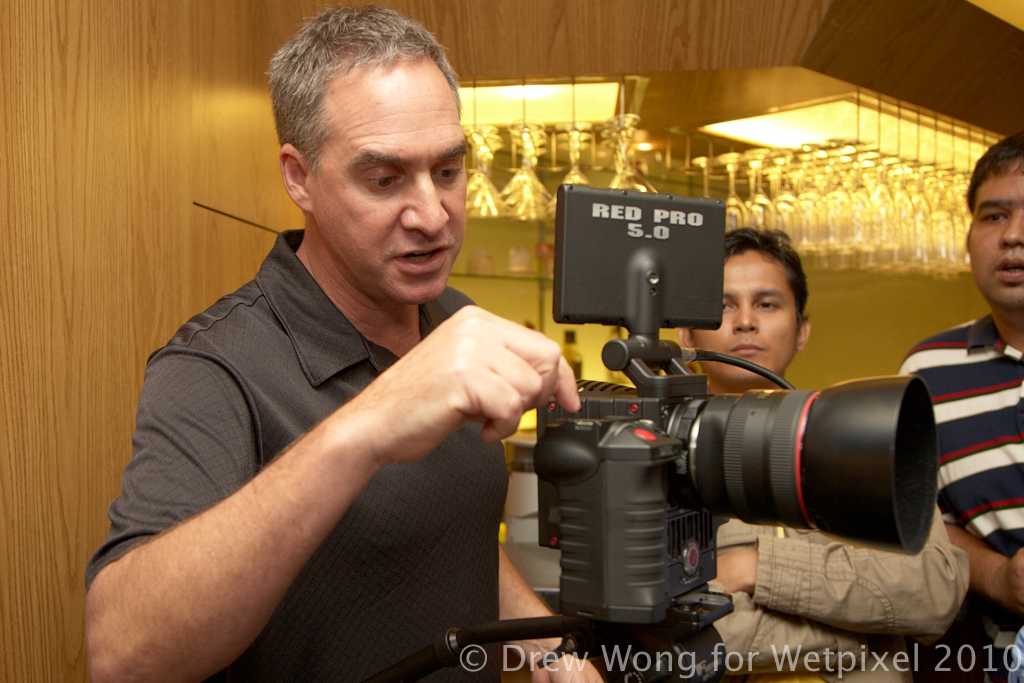
Ted Schilowitz explaining the functions on the Epic
The talk began with a brief history of the Red One. Then like a proud parent, Ted scrolled down the many productions (feature films, broadcast and ad work) that used the Red One camera. He then mentioned the productions currently using the Red One Mx cameras in 3D, like the 4th installment of Pirates of the Caribbean, which apparently is the biggest budget production Red cameras have been used by a movie mile, using over 20 units for the shoot. In fact, a single production unit was bigger than entire productions in terms of production budget. He also mentioned David Fincher was in Sweden shooting the remake of the Stieg Larson novel, Men Who Hate Women (The Girl With The Dragon Tattoo). Then the demo reel rolled…
Cathay Cineplex uses the Sony SXRD 4K projector with RealD 3D technology, one of the few venues in Singapore (and the region). Unfortunately the demo reel was 2D and the projector would loose optimized because the 3D system uses a silver screen, optimized for 3D, which meant the blacks wouldn’t be as nice as if a white screen was used. For the 200+ people who showed up, it didn’t seem to matter when the first clip popped up. Resolution was resolution and the 14 megapixel MX sensor captured some gorgeous images. The MX clips were from Martin Scorsese’s Shutter Island which took advantage of the MX sensor’s sensitivity, pushed to ISO2000 using a T1.3 lens, to create a nice rear lit scene where Leo DiCaprio lights a cigar and is illuminated only by the flame of a match and the cigar burning, all at 4k resolution.
Shutter Island scene lit by flame of a match, ISO2000 with T1.3 lens at 23.98fps.
It has to be said that the Canon 5D Mark II can beat that performance, at a much lower resolution. Regardless, on the big screen, even with a silver screen, the noise level (or lack there of) was impressive.
After the demo reel, Ted went on to compare the Red One to the F23/35, Canon 5D mark II and Arri Alexa, showing resolution charts and zone plates which highlight the resolution superiority of the Red One.

The zone plates of the 7D, F35 and Red MX at 2k resolution.
The Epic-X
** I must add this friendly warning before you read on: The Epic-X shown was a prototype. Specs are not finalized and obviously they have some issues to deal with. However it was a working prototype but caution should be taken as to how the camera is described. It is not a shipping product and thus this overview shouldn’t be taken as gospel as how the shipping camera will perform. The Epic has already been used to shoot several covers for magazines and videos.
With all the marketing over, Ted pulled out of his bag the reason why we were all crammed into that 18°C cinema… the Epic-X prototype (Codenamed Tattoo). He immediately said that the prototype was not a demo, so no one could handle it since specs can change. However it was a working prototype with a Canon EF85mm f1.2L lens on it. There was also the Red Pro 5.0 Touch Screen LCD monitor attached. Ted explained about the Digital Stills and Motion Camera (DSMC) concept, that the motion picture industry which the Red One has moved to be a big player in the film industry and also broadcast TV. The industry’s demand for a small and light camera which had the versatility of shooting 5k resolution while retaining the ability to shoot a 14mp still shot is growing. Quite a few magazines have already put still images from a Red One camera and Epic on the cover, including Vogue and Time. The ability to choose frames shot at 120fps is nice, and for higher resolution, the camera will record both 5k and 14mp images at the same time without interruption.
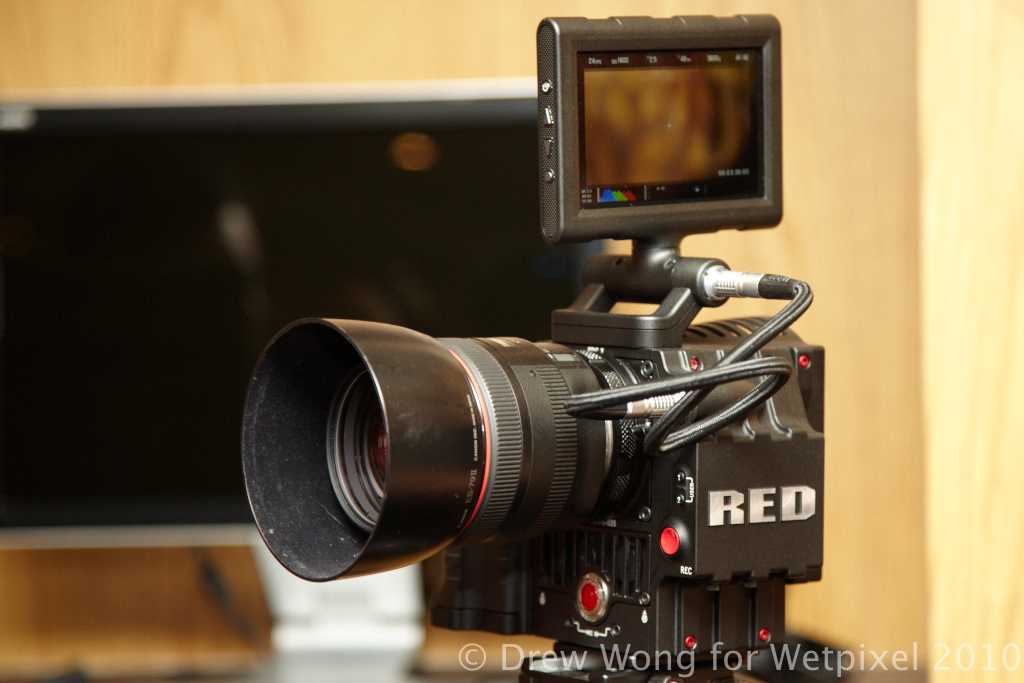
The Epic-X prototype with a Canon EF85mm f1.2 lens and Red Touch Screen LCD monitor
Firing it up, you could hear the fan whirring away as the camera booted, especially in a soundproofed auditorium. I was about 5 rows away from where the camera was and could hear the fans. The camera took about 7-10 seconds to fully boot and fully operational.
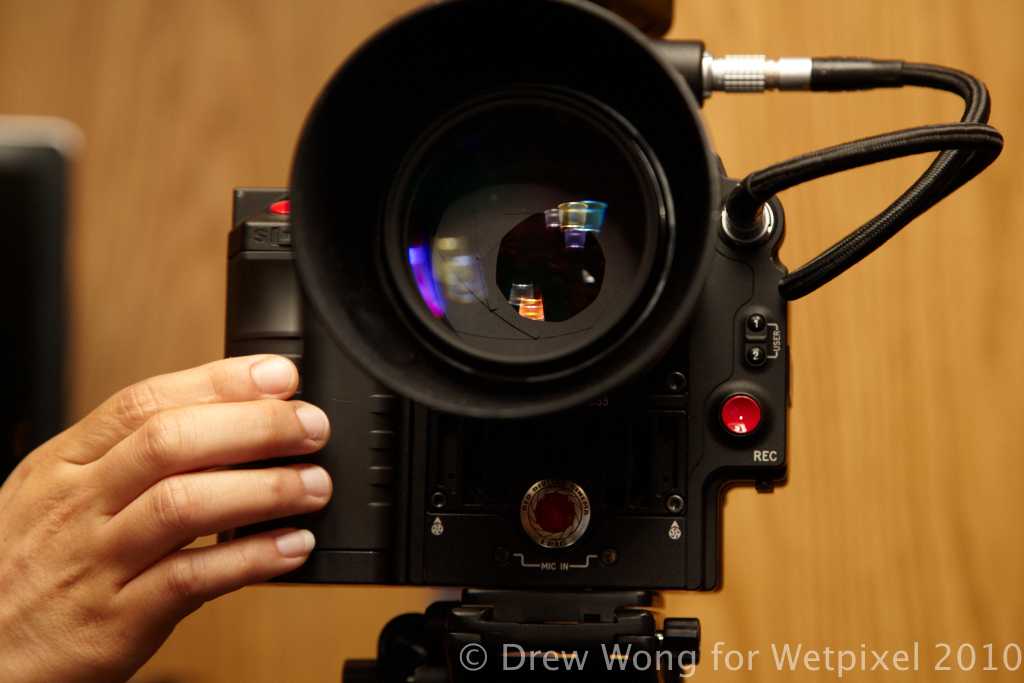
Note the vents for the fans below the lens. Also note the size of the camera relative to the hand (which is a medium large hand of a medium sized 5’10” man)
Ted then went on to talk about the Epic plans and accessories available. The design of the Epic is modular, much like the Red One. With this design, recording give a plethora of choices from using CF cards and 1.8” SSD drives using R3D to recording through HD SDI. More interesting are the planned accessories like the H.264 module, which records HQ H.264 1080p stream to a separate CF card, on the fly, while recording to the main memory @ 5k resolution. The REDMOTE wifi remote control has the ability to control the basic functions of the camera from 100ft away. The planned REDMOTE PRO adds focus and Autofocus control to the mix. To add to the DSMC offering, Red also will be releasing the Red electronic lenses like the 15-25mm which are fully electronically controlled like EF and Nikkor mounts, with AF. Compatibility with Red One and Epic will be through a lens mount, much like the Canon and Nikon mounts.
HDRx in MysteriumX sensors promises up to 18 stops of dynamic range. Sensors normally have about 13+ stops of DR. Red has come up with a process “trick”, by capturing 2 images at the same time, one exposed to foreground and another exposed to the blown highlights. It then blends the 2 together to form a HDR picture. A side effect of this blending process, which uses shutter speed to control exposure on the second frame, is that you will see the motion blur of having a 180° shutter but because the blended image uses the higher shutter speed which freezes motion a lot more, you can also see the subjects without motion blur. This following example will show you what I mean:
Download higher res demo clip here.
As you can see, the lights aren’t blown out but the shadows are well lit as well. The motion effect I mentioned is most significant when the fire truck passes by. If you pause the image, in some parts of the image you see the ghosting of motion blur but the words Las Vegas on the truck is sharp. But it isn’t steady as it too blurs and then sharpens again as the pan follows. It’s an interesting side effect and I’d be interested to see how it’s used. The Epic is capable of dialing the number of stops the HDRx engine brackets for, making it highly customizable to create a look in camera vs in post.
During the upclose demo, Ted showed off the Touch Screen Autofocus function of the RED PRO 5.0 monitor. By just tapping on the screen on the part of the image he wanted to focus on, the camera would focus on the area using phase detection + contrast. The AF function is being worked on as it’s neither fast or accurate at the moment. It struggled with faces in normal lit room and searched a few times. Still it works for Canon, Nikon and Red’s forthcoming lenses (if we could only do that for our DSLR right now!) In addition to AF, the Red Pro 5.0 Touch Screen LCD monitor will be a functional control for many of the features the camera has in the menus as well as being histogram/exposure/info monitor.
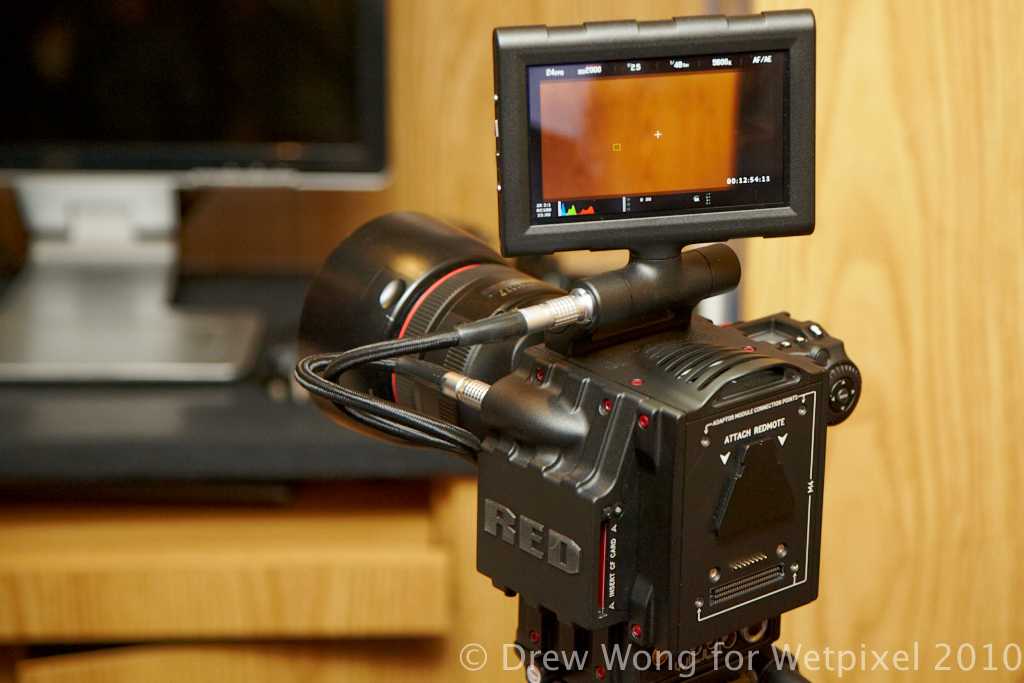
The Epic and the LCD Touch Screen monitor and CF card module
Physically the camera is slightly bigger than a Leica S2, without the RED BOMB EVF or LCD monitor. The setup is very much like a science fictioned up DSLR, with a metallic alloy body and that modular design demand quite a few I/O interfaces and also screw points to attach modules. This form factor is pretty exciting when you think you are able to shoot at 5k resolution and take stills with AF.
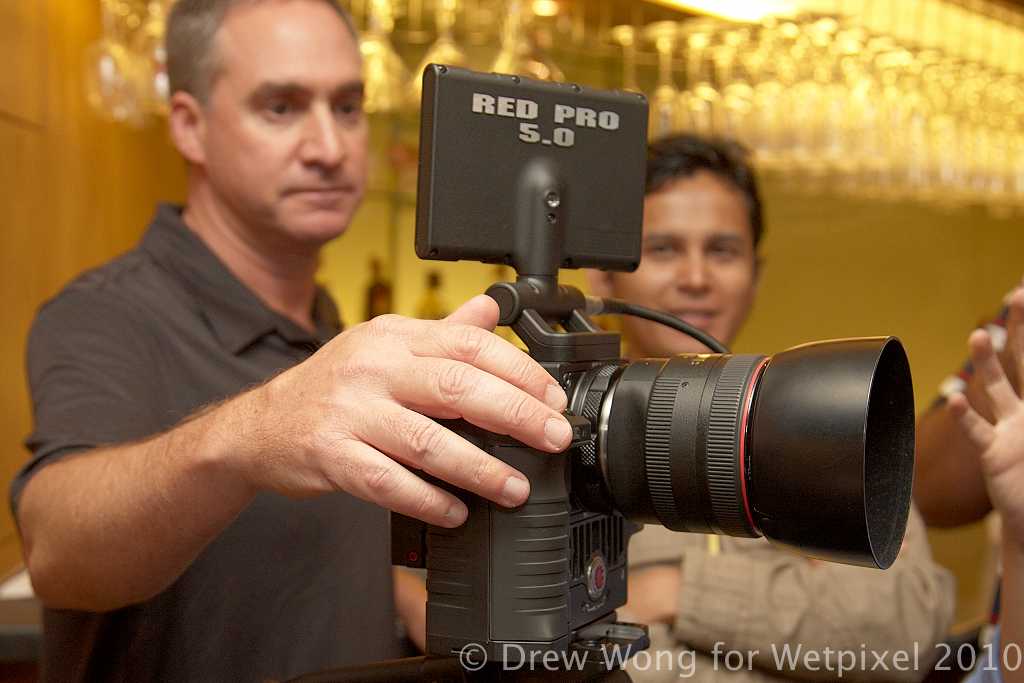
The Epic with Ted’s hand as scale.
As I write this, the Epic is now at work on several fashion shoots and film projects, even while on prototype status. This means the camera’s basic functions are pretty much ready to go but the peripherals aren’t ready yet. As usual, Ted Schilowitz was very coy when mentioning ship dates, saying ‘It’ll be ready when it’s ready!’ He did touch on Scarlet a bit but with no shipping dates or camera availability, the Epic show was basically a marketing campaign for the company and its one shipping product, the Red one, and what prospective products that will be coming along in the future. Red certainly knows how to build hype in the industry and they certainly have pushed cinematography to a new level with larger sensors and smaller cameras and easier workflows now the focus of all the big companies. The Mysterium X sensor is one of the few sensors which can shoot at 4k for under 50k right now and that’s something to be excited about!
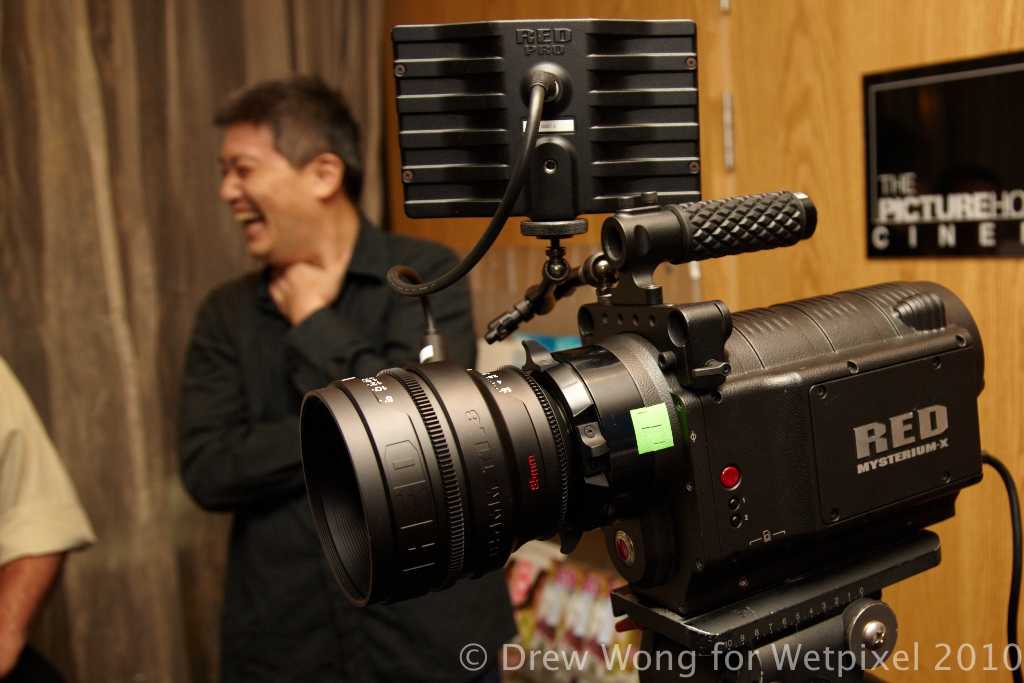
With all the hype, one could almost forget the Red One with MX sensor, even though it’s still a very capable camera at the venerable age of 3.
** Latest news: Red’s Jim Jannard has announced on Nov 5th that the Epic-X is ready for production. Actual production has not started and the Epic will have “at least 95%” of the features promised by the time production starts.